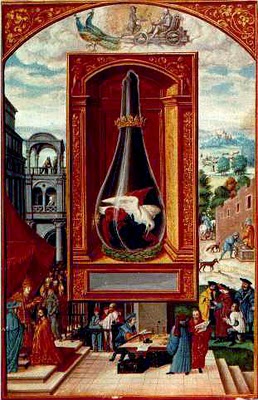Eliade, Jung and Alchemy
While trying to understand the thinking of Eliade and Jung, I came across this article by Cerena, a graduate in Mythological Studies from Pacifica Graduate Institute… Interesting reading about a very important topic:
Alchemy and the Hermetic Tradition: Mircea Eliade and Carl Jung
August 9, 2009

(Excerpts)
The relationship between Mythology and the Religious traditions is an intricate weaving of metaphor. Both Mythology and Religion have the similar function of relating lived experience to a universal purpose. Often, religion relates life choices to divine models, while Mythology creates narratives that contextualize experience. In many instances mythology and religion function simultaneously. However, a major distinction between the two traditions is that mythology is defined as an adaptive narration, and dogmatic perspective restricts religion to a lived mythic model. Though there is a wide continuum of religious interpretation ranging from orthodox to eclectic, as a lived mythology, religion is a lens that the world is seen through. To clarify, there is a specified Catholic religious lens that filters mythology to fit a defined vision of the universe. Many mythologies have foundations in cultures that are no longer active, such as in the Greek and Roman myths…
A specific example of the relationship between myth and religion is better understood through the mythology surrounding the Alchemical Tradition as explored by the theorists, Mircea Eliade and Carl Jung…
A working understanding of Alchemy includes both scientific method and spiritual symbolism. A series of elemental transformations is intended to create a new material. However, these changes are not just dependent on following a physical recipe, they must also incorporate symbolic relationships. The basic alchemical sequence begins with a male and female sealing the prima materia (original substance) into a vessel…
Mircea Eliade and Carl Jung are two twentieth century theorists who explore the implications of alchemy in a modern context. Each theorist has a working definition of mythology that reveals how the study of alchemy is an important mythological structure. The challenge that both writers have in defining myth is that it is the nature of myth to transform boundaries. In Myth and Reality, Eliade attempts a definition:
Myth narrates a sacred history; it relates an event that took place in primordial Time…it relates how something was produced, began to be.
This definition focuses on the method of mythology. He emphasizes that myth is based on creation stories, which are connected to what is sacred in a culture.
In Alchemical Studies Carl Jung is less explicit with his definition of mythology:
Even though mythology may not be ‘true’ in the sense that a mathematical law or a physical experiment is true, it is still a serious subject for research and contains quite as many truths as a natural science; only, they lie on a different plane. One can be perfectly scientific about mythology, for it is just as good a natural product as plants, animas or chemical elements.
Jung states that both myth and science reveal truths, however mythic are understood in a different method than scientific truths. He also states that both myths and the elemental world are naturally occurring.
While both Eliade and Jung agree that myths are an integral part of human perspective, Eliade focuses on myths as reflecting the sacred in narrative synthesis, while Jung emphasizes mythology as a process similar to other natural phenomena.
In The Forge and the Crucible: The Origins and Structures of Alchemy, Eliade explores how alchemy connects the physical and the sacred through a variety of cultural contexts. Beginning with “Meteorites and Metallurgy”, Eliade states:
He continues to explain how the exploration of metallurgy was connected to a spiritual understanding of the universe, emphasizing that in many cultures smiths, or metal workers, held an elevated status in a community…
In contrast, Jung articulates alchemy as a metaphor for psychological functions. Alchemy is symbolic of figurative functions within the psyche as revealed by a variety of myths found in visions, myths and symbols. Jung states that
The alchemist […] dreams in his own specific language .. We have [to] learn the psychological secrets of alchemy… The symbolism of alchemy has a great deal to do with the structure of the unconscious… The confrontation with the unconscious usually begins in the realm of the personal unconscious, that is, of personally acquired contents which constitute the shadow, and from there leads to archetypal symbols which represent the collective unconscious. The aim of the confrontation it to abolish the dissociation…
As a tradition, the role of alchemy may be observed from several perspectives. Eliade argues for the connection of physical phenomenon to the sacred, while Jung creates a metaphorical connection between the symbolic functioning of archetypes in the collective unconscious and individual psychology. While Eliade and Jung enter into an understanding of Alchemy with different strategies and goals, they both argue for the importance of alchemy in the generating of myth throughout global communities…
Source: Cerenity Now: Meta-Mythology

Splitting hairs: Main difference between mythology and religion? Mythology is usually what you call other peoples’ religion… (usually “the dead ones” but on occasion…)
Love the alchemical connection…